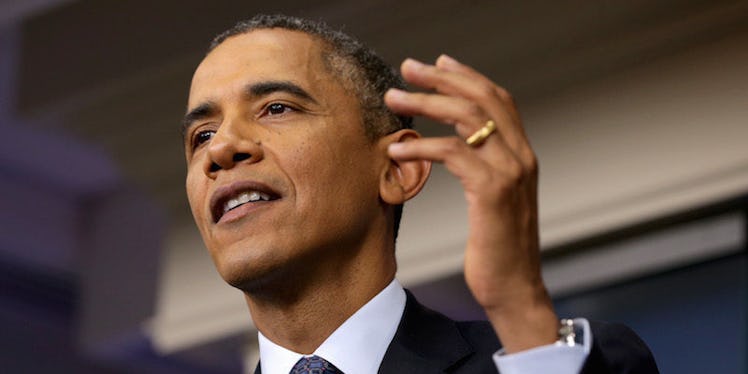
How Obama And The SAFE Justice Act Will Push Prison Reform
Yesterday, President Obama became the first sitting president in history to tour a federal prison.
His trip to the El Reno federal facility in Oklahoma was designed to highlight the failures of the criminal justice system, stemming from his recent address to the NAACP, where he argued that “[m]ass incarceration makes our country worse off, and we need to do something about it.”
The Oklahoma tour is just one part of a larger effort by the administration to implement executive reforms for federal prisons.
Last week, Obama granted clemency to 46 people who faced lengthy sentences for nonviolent crimes. Among those commuted, 13 faced life in prison for drug crimes.
While it is encouraging to see Obama highlight the issue of prison reform, his efforts to alleviate problems within the criminal justice system merely scratch the surface of a much larger travesty.
Consider the following facts:
- There are 2.4 million people in prison.
- Half are serving sentences for nonviolent offenses.
- There has been over a 750 percent increase in federal prisoners since the Reagan administration.
- Millennials make up nearly 40 percent of the federal prison population.
- Over half of prisoners in state-run prisons are in their 20s and 30s.
- Up to 41 percent of all young people have been arrested by the time they turn 23.
- Eighty percent of defendants cannot afford an attorney to represent their case.
- Over 3,278 people are serving life without parole for nonviolent crimes.
- For those seeking commutation of a sentence, the odds that President Obama will grant their petition is less than 1 in 5,000.
To put it simply, the criminal justice system is broken.
What can explain our high incarceration rates? Much of it can be traced to an increase in the number of laws that impose harsh penalties.
Since 1980, Congress passed over 2,000 criminal laws, bringing the total amount on the federal books to over 4,500.
The proliferation of laws coincided with harsher sentencing guidelines that recommended longer, and even mandatory, punishments that delivered thousands of people to a fate of years behind bars.
Today, the United States has 5 percent of the world's population, but it holds 25 percent of all prisoners.
Indeed, as William J. Stuntz, the late professor of law at Harvard University noted, “America first embraced punishment levels lower than Sweden's, then built a justice system more punitive than Russia's.”
As President Obama toured the prison in Oklahoma, he might have asked himself, “Is this really the land of the free?”
Mass incarceration is about more than numbers and statistics, though. Take, for example, the story of Weldon Angelos, a young American whose petition for clemency was denied by President Obama.
When Weldon was just 24 years old, he made the mistake of selling small amounts of marijuana to a federal law enforcement informant three times, worth less than $1,000.
Because federal agents observed that Weldon carried a gun during these transactions (though he never used it), his punishment was increased to 55 years in prison.
The judge in his case, Paul Cassell, told Weldon he did not want to give him such a long sentence, stating it was “unjust, cruel, and even irrational,” but he was bound by congressional sentencing guidelines that imposed mandatory punishments.
Judge Cassell noted that Weldon's sentence is longer than if he were convicted “for three aircraft hijackings, three second-degree murders, three racial beatings inflicting life-threatening injuries, three kidnappings, and three rapes.”
Unless President Obama intervenes, Weldon will stay in prison until he is 78. He will miss birthdays, Christmas celebrations and other important life events. The first memory his grandchildren will have of Weldon is an image of him behind bars.
The president has the authority to grant clemency to Weldon and others like him. He should.
In the meantime, Congress has an opportunity to pass meaningful reform that could directly help people like Weldon.
Rep. Jim Sensenbrenner (R-WI) and Rep. Bobby Scott (D-VA) introduced the Safe, Accountable, Fair and Effective (SAFE) Justice Act, which is designed to curtail over-criminalization and reduce the federal prison population.
If enacted, this bipartisan legislation could truly help people like Weldon who were sent to prison for youthful mistakes.
The reforms include reducing mandatory minimums and putting discretion back in the hands of judges.
Instead of sending people to prison for “unjust” or “irrational” amounts of time, the SAFE Justice Act clarifies that mandatory minimum sentencing should be focused on the leaders and organizers of crime rings rather than those who are low-level offenders.
Additionally, instead of exclusively using the prison system to punish people, the bill endorses intervention methods, problem-solving court programs and treatment centers as a way to avoid prison time.
This measure could directly help end the increase in the number of people who are locked up in prison for first-time offenses.
While there is much more that needs to be done to reform the criminal justice system, the SAFE Justice Act addresses several fundamental problems that lead to an increased federal prison population.
Here's to hoping President Obama will apply the knowledge he gained during his prison tour to encourage real reforms for our incarcerated nation.